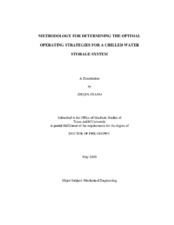| dc.contributor.advisor | Turner, William D. | |
| dc.creator | Zhang, Zhiqin | |
| dc.date.accessioned | 2011-08-08T22:47:46Z | |
| dc.date.accessioned | 2011-08-09T01:33:35Z | |
| dc.date.available | 2011-08-08T22:47:46Z | |
| dc.date.available | 2011-08-09T01:33:35Z | |
| dc.date.created | 2010-05 | |
| dc.date.issued | 2011-08-08 | |
| dc.date.submitted | May 2010 | |
| dc.identifier.uri | https://hdl.handle.net/1969.1/ETD-TAMU-2010-05-7790 | |
| dc.description.abstract | This dissertation proposed a new methodology for determining the optimal
operating strategies for a chilled water storage system under a Time-of-Use electricity
rate structure. It is based on a new classification of operating strategies and an
investigation of multiple search paths.
Each operating strategy consists of a control strategy and the maximum number
of chillers running during the off-peak and on-peak periods. For each month, the strategy
with the lowest monthly billing cost and minimal water level higher than the setpoint is
selected as the optimal operating strategy for the current month. A system model is built
to simulate the tank water level at the end of each time step and the system total power
during each time step. This model includes six sub-models. Specifically, the plant model
is a forward model using a wire-to-water concept to simulate the plant total power. For
the Thermal Energy Storage (TES) model, the tank state is described with total chilled
water volume in the tank and its derivation is the tank charging or discharging flow rate.
A regression model is adopted to simulate the loop supply and return temperature difference as well as the loop total flow rate demand. In the control strategy sub-model,
except for three conventional control strategies and the operation without TES, a new
control strategy is advanced to load the chiller optimally. The final results will be a table
showing the monthly control strategy and maximal number of chillers staged on during
the off-peak and on-peak periods, an approach which is easy for the operators to follow.
Two project applications of this methodology are introduced in this dissertation.
One is an existing TES system with state-of-the-art control and metering systems. The
monthly optimal operating strategies are generated, which will achieve significant
savings. The comparisons among different control strategies are also provided. The other
application consists of multiple plants with little data. The purpose of the study is to
evaluate the economic feasibility of designing a new chilled water storage tank and
sharing it among four plants. This problem can be solved with a simplified system
model, and an optimal tank size is recommended. | en |
| dc.format.mimetype | application/pdf | |
| dc.language.iso | en_US | |
| dc.subject | thermal energy storage | en |
| dc.subject | chilled water plant | en |
| dc.subject | Time-of-use rate structure | en |
| dc.subject | operating strategy | en |
| dc.subject | chiller plant model | en |
| dc.title | Methodology for Determining the Optimal Operating Strategies for a Chilled Water Storage System | en |
| dc.type | Thesis | en |
| thesis.degree.department | Mechanical Engineering | en |
| thesis.degree.discipline | Mechanical Engineering | en |
| thesis.degree.grantor | Texas A&M University | en |
| thesis.degree.name | Doctor of Philosophy | en |
| thesis.degree.level | Doctoral | en |
| dc.contributor.committeeMember | Claridge, David E. | |
| dc.contributor.committeeMember | Culp, Charles H. | |
| dc.contributor.committeeMember | Heffington, Warren M. | |
| dc.type.genre | thesis | en |
| dc.type.material | text | en |


